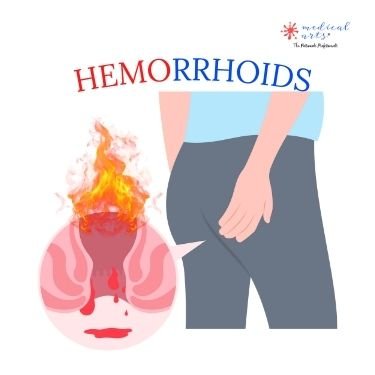Understanding Hemorrhoids: Symptoms, causes and treatment.
Introduction
Hemorrhoids, also known as piles, are a prevalent condition affecting millions of people worldwide. Despite their frequency, they remain a sensitive topic many individuals hesitate to discuss. This guide aims to shed light on the causes, symptoms, and treatment options for hemorrhoids.
What Are Hemorrhoids?
Hemorrhoids are swollen and inflamed veins in the rectum and anus that can cause discomfort, itching, and bleeding. They are categorized into two primary types:
- Internal Hemorrhoids: Located inside the rectum and usually painless, they may bleed.
- External Hemorrhoids: Found under the skin around the anus and can cause significant pain and discomfort.
Grading of Hemorrhoids
Internal hemorrhoids are often classified based on the severity of their prolapse:
- Grade 1: No prolapse; present inside the rectum.
- Grade 2: Prolapse upon straining but retracts spontaneously.
- Grade 3: Prolapse upon straining and requires manual reduction.
- Grade 4: Irreducible and remains prolapsed.
Causes and Risk Factors
While the exact cause of hemorrhoids remains unclear, several factors may contribute to their development:
- Chronic Constipation or Diarrhea: Straining during bowel movements can increase pressure on rectal veins.
- Pregnancy: The pressure from the growing uterus and increased blood flow can enlarge veins in the rectal area.
- Obesity: Excess weight can add pressure to rectal veins.
- Prolonged Sitting or Standing: Remaining in one position for long periods can hinder blood flow.
- Aging: Tissue in the rectal area becomes weaker with age.
Symptoms
The symptoms of hemorrhoids can vary based on the type and severity but generally include:
-
Internal Hemorrhoids:
- Painless rectal bleeding (bright red blood on stool or toilet paper)
- Prolapse (hemorrhoid protruding from the anus)
-
External Hemorrhoids:
- Anal itching or irritation
- Pain or discomfort, especially while sitting
- Swelling around the anus
- Bleeding (if the hemorrhoid is thrombosed)
Diagnosis
Medical professionals typically diagnose hemorrhoids through:
- Physical Examination: Inspecting the anal area for external hemorrhoids or a prolapsed internal hemorrhoid.
- Digital Rectal Exam (DRE): Feeling for abnormalities inside the rectum.
- Anoscopy/Proctoscopy: Using a small tube to inspect internal hemorrhoids.
- Sigmoidoscopy/Colonoscopy: Recommended if the patient has significant bleeding to rule out other conditions.
Treatment Options
1. Conservative Treatments
- Dietary Changes: A high-fibre diet and increased water intake can help soften stool and reduce straining.
- Over-the-counter (OTC) Medications: Creams, ointments, and suppositories containing hydrocortisone or witch hazel can provide temporary relief.
- Sitz Baths: Soaking the anal area in warm water for 10-15 minutes several times a day can alleviate discomfort.
2. Medical Procedures
- Rubber Band Ligation: Placing a rubber band around the base of an internal hemorrhoid to cut off its blood supply, causing it to shrink and fall off.
- Sclerotherapy: Injecting a chemical solution into the hemorrhoid to shrink it.
- Infrared Coagulation: Using infrared light to coagulate blood vessels reduces hemorrhoids.
- Hemorrhoidectomy: Surgical removal of large or severe hemorrhoids.
- Stapled Hemorrhoidopexy: Stapling the hemorrhoid back into place is often less painful than traditional hemorrhoidectomy.
3. Lifestyle Modifications
- Regular Exercise: Encourages bowel regularity and reduces pressure on rectal veins.
- Avoiding Straining: Don't delay bowel movements; avoid sitting for prolonged periods.
Prevention Strategies
- High-Fiber Diet: Incorporating whole grains, fruits, and vegetables into the diet can prevent constipation.
- Stay Hydrated: Drinking plenty of fluids aids digestion and stool softening.
- Exercise Regularly: Regular physical activity promotes healthy bowel movements.
- Good Bathroom Habits: Avoid straining and don't delay bowel movements.
When to See a Doctor
While hemorrhoids can often be managed at home, medical attention should be sought if:
- Rectal bleeding is significant or persistent.
- Symptoms persist or worsen despite treatment.
- There is severe pain or discomfort.
Conclusion
Though common and often uncomfortable, hemorrhoids can usually be managed with a combination of lifestyle changes, conservative treatments, and medical procedures. By understanding the causes, recognizing symptoms, and seeking appropriate treatment, individuals can effectively address this condition and improve their quality of life.

